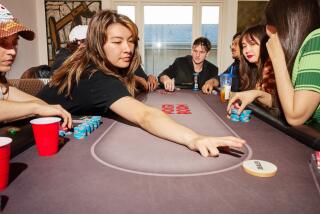Global in Its Appeal, Backgammon Is on a Roll
- Share via
Felt-lined briefcases lie open-faced, occupying every available surface at the A.R. Private Club, a small space in a strip mall near the Beverly Center. It’s after midnight and opposing players are staring intently into the sharp-toothed maw of their backgammon boards.
Fueled by complimentary Krispy Kremes and coffee, champions and amateurs alike were here competing for cash and status at the 48th annual Gammon Associates Invitational over the weekend. About 80 contenders played more than 250 matches over the course of three days.
Early in the tournament, all eyes are on Chicago’s Jake Jacobs, rated as the top player in the U.S. by the American Backgammon Tour. But after a few early upsets, he is out of the open division, leaving victory to be claimed by one of the lesser knowns. “You can’t win them all,” says Jacobs without a trace of bitterness. It’s a game of skill, yes, but chance as well. “People have streaks.”
Sho Sengoku, a delicate Japanese player from San Diego is definitely on a streak. He is intense, systematic and unflappable. Whereas some players are prone to the occasional forehead slapping or whoops of triumph, Sengoku is expressionless, silently calculating probability equations as he contemplates a doubling cube challenge.
Tournament backgammon players are an eclectic group, though all tend to be obsessed with what’s been called “the cruelest game,” in which players race to clear 15 checker-like pieces from the board before their opponent. On any given night you’ll find Iranians playing South Americans, college students playing retired hotel moguls.
“You get a wide assortment of people playing tournament backgammon,” says Norm Wiggins, a retired fire captain from Palmdale. “Regular working people and astrophysicists, an awful lot of computer people.”
“Don’t forget degenerate gamblers,” a player chimes as he rolls by.
One of L.A.’s greatest champion players is Patrick Gibson, who has been running Gammon Associate tournaments here for 23 years. It’s Gibson who decides who plays in which division and who plays whom. “It’s somewhat subjective,” he says. “But I am Mr. Subjective.” He commands respect as he half-jokingly barks orders at the players to speed up their matches, pencils in the wins on a huge wall chart and, most important, writes the prize checks.
These tournaments give players a chance to meet some of the people they know only from the increasingly popular online gaming sites where willing partners can be found to play for stakes at any time, day or night.
Gibson’s invitational is the largest in Southern California, attracting players from around the world. He also runs two regional tournaments every week. The biggest U.S. tournaments are in Las Vegas with top prizes upwards of $20,000, but the invitational’s top payoff this weekend is $5,700, with many other four-digit prizes to follow.
While players welcome such winnings, the payoffs pale in comparison to the game’s apex in the early 1980s when jackpots like the Plimpton Cup hit $180,000. Players would get obsessed, playing for 13 days straight, Jacobs says. “We would start seeing spots.”
Backgammon can be traced back to ancient Persia and the pyramids of Egypt, but “it’s a shadow of its former self,” says Bob Wachtel, a writer who has been playing for more than 20 years. “In the late ‘70s, it was a glamorous avocation.”
Wachtel says the jet-set disco crowd in America eagerly appropriated the trappings of European gentlemen’s clubs. “A man in a tuxedo playing on a bearskin rug with a snifter of Hennessy ... it became part of cool culture.” Huge sums of money were won and lost. “Guys in open shirts and gold dripping down their chests were willing to lose $3,000 in a night,” Wachtel says. Pips in Beverly Hills was a backgammon hotspot.
While no longer glamorous, perhaps, the game is experiencing an upsurge in popularity, Jacobs says, with hundreds of private regional clubs nationwide and an ever-increasing electronic community of players. In some Middle Eastern countries, backgammon is the national pastime.
By late Sunday night, the crowd has thinned, and Jacqui Lee, a cash-flow analyst from Singapore, has swept the advance division. Doug Mayfield, an anesthesiologist from Los Angeles, took the Super 32.
Sengoku is still rolling. The club’s photographic wall murals of fresh landscapes contrast with the blank overhead lighting and stale smell of fast food. Sengoku is oblivious to the material world around him. Eyes are focused on points, pieces and the die.
“It’s really one of the best games in the world,” Wiggins says. “It’s easy to learn and extremely hard to play well. Unlike chess, it’s not all intellect. There’s the luck and vagaries of the die--some of them pleasant, some of them unpleasant.”
More to Read
Go beyond the scoreboard
Get the latest on L.A.'s teams in the daily Sports Report newsletter.
You may occasionally receive promotional content from the Los Angeles Times.










